Unveiling the Core Principles and Significance of the ABC Model
Applied Behavior Analysis (ABA) stands as a scientifically supported approach that focuses on understanding and modifying behavior through careful analysis of environmental factors. Rooted in principles of reinforcement and punishment, ABA employs structured techniques and detailed data collection to foster meaningful behavioral changes. Central to this approach is the ABC model—Antecedents, Behavior, and Consequences—which provides a framework for deciphering the complex interactions that influence behavior, especially in individuals with developmental challenges such as autism. This article delves into the fundamental principles of ABA, highlights the importance of understanding the ABCs of behavior, and explores how these components are applied to improve everyday functioning and social participation.
Fundamental Principles of ABA Therapy
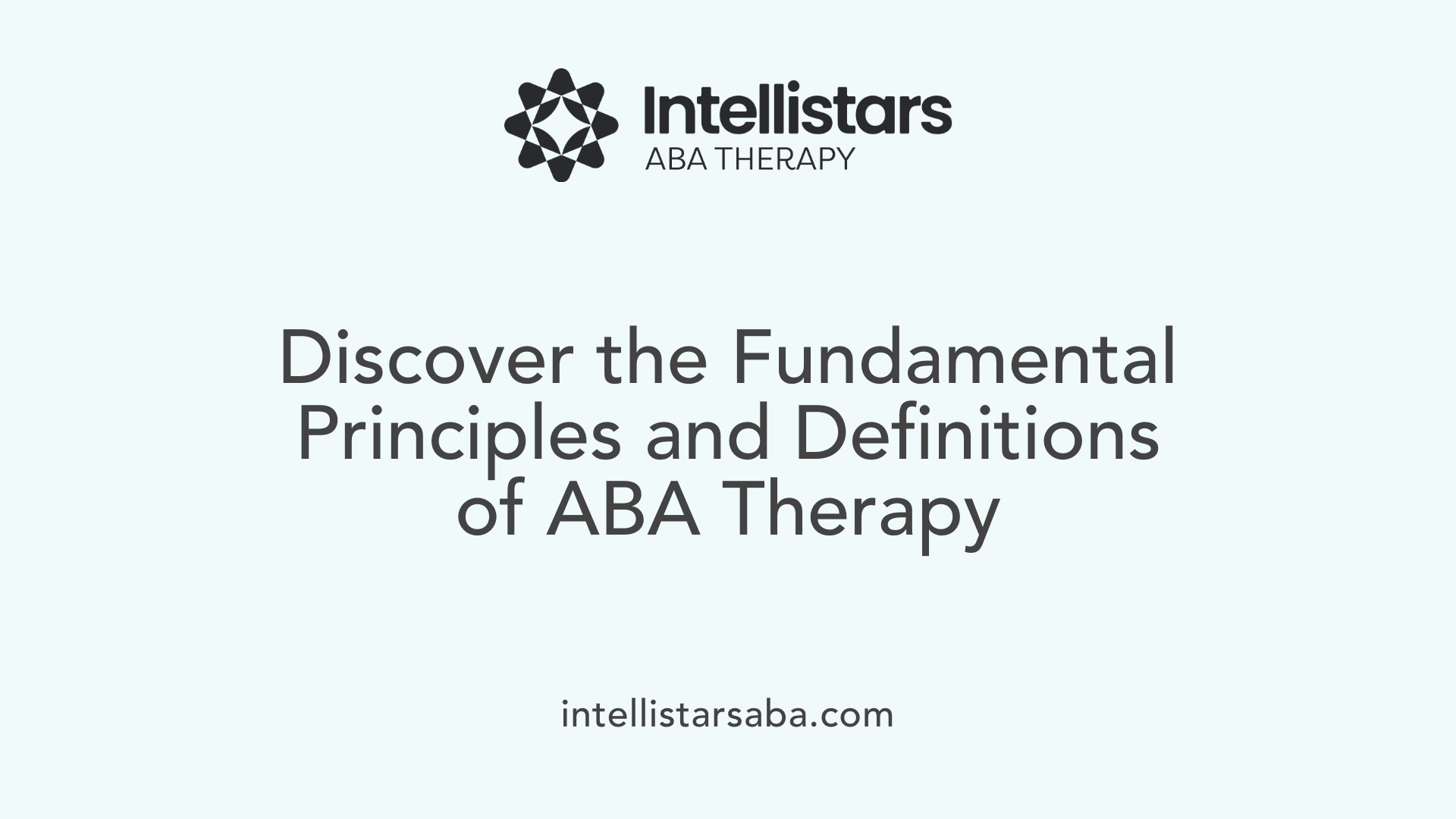
What are the fundamental principles and definitions of ABA therapy?
Applied Behavior Analysis (ABA) is a scientific approach that focuses on understanding and modifying behaviors by examining the environment's influence. It involves careful observation and measurement of behaviors, along with their triggers (antecedents) and outcomes (consequences). The primary goal of ABA is to promote positive, functional behaviors that help individuals succeed in daily life.
The core idea behind ABA is that behaviors are learned and can be changed. This includes both helpful actions, such as communication and social skills, and problematic behaviors that may interfere with learning or safety. By analyzing how specific stimuli and reactions are connected, practitioners develop personalized strategies to encourage desirable behaviors and diminish maladaptive ones.
This method rests on fundamental psychological principles like reinforcement—where positive outcomes increase the likelihood of behaviors—and punishment, which discourages unwanted actions. The three-term contingency, or ABC model, is central in ABA: it considers the Antecedent (what happens before the behavior), the Behavior itself, and the Consequence (what happens after the behavior). Understanding this pattern helps tailor interventions effectively.
ABA employs structured techniques such as Discrete Trial Training (DTT), which involves giving clear instructions, observing responses, and applying rewards or corrections. Additionally, functional behavior assessments analyze why behaviors occur by collecting detailed data on antecedents and consequences. This information supports creating Behavior Intervention Plans that aim to change behaviors in meaningful ways.
Although ABA is well-known for its application in helping children with Autism Spectrum Disorder (ASD), its principles are adaptable across various settings and for different populations. The flexibility and data-driven nature of ABA make it a powerful approach for developing skills and reducing behaviors that hinder an individual's growth and well-being.
Understanding the Significance of the ABCs of Behavior
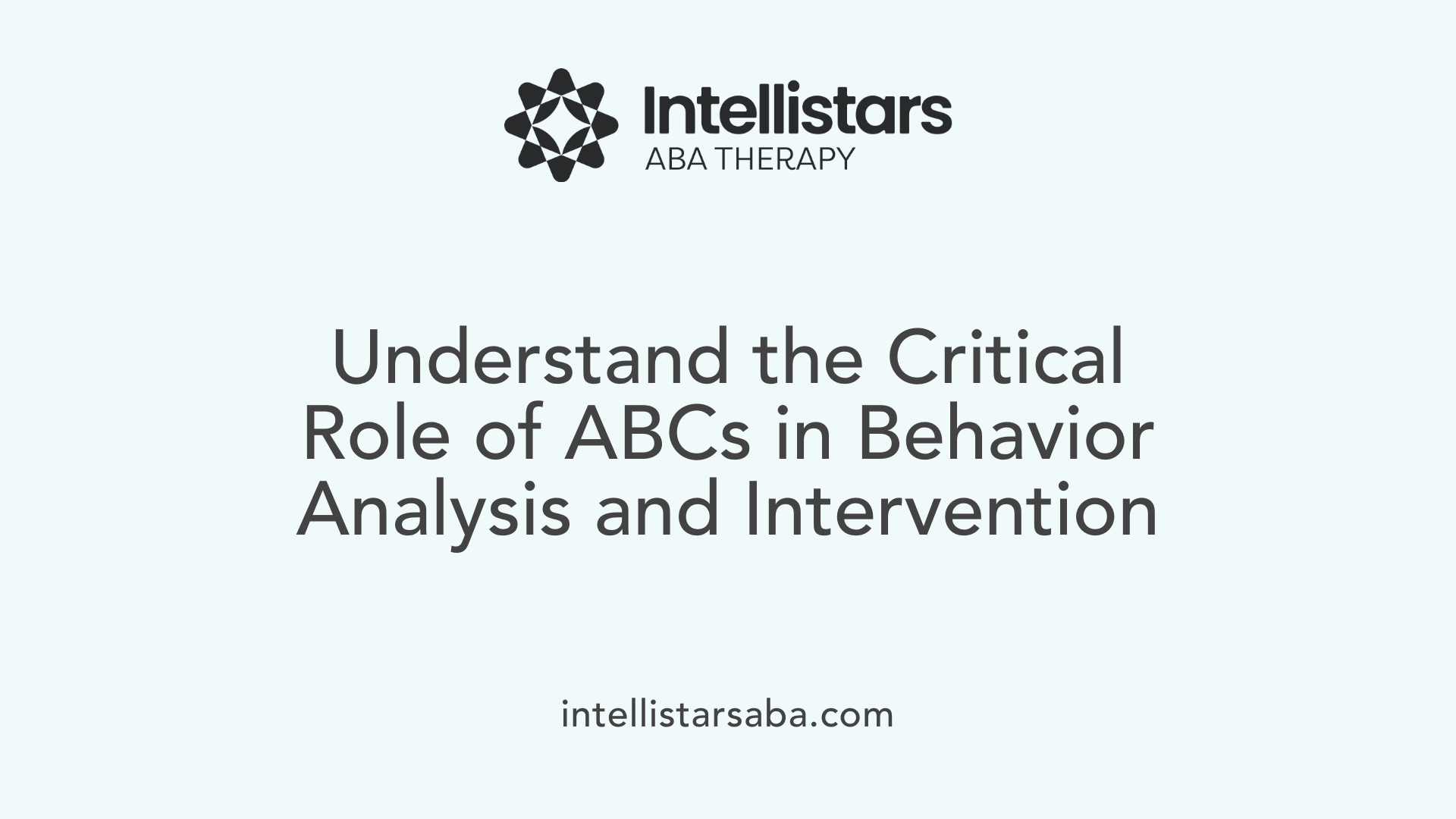
Importance of ABC model
The ABC model—comprising Antecedents, Behaviors, and Consequences—is fundamental in understanding how and why behaviors occur. It provides a structured framework for analyzing actions by looking at what happens before a behavior (antecedents), the behavior itself, and what follows afterward (consequences). These components are especially important in behavior modification because they help identify triggers and functions of behaviors.
This approach is rooted in principles of operant conditioning, first introduced by B.F. Skinner in the 1950s. Over the decades, particularly in the 1970s with the development of ABA therapy by Ivar Lovaas, the ABCs have become essential tools for behavioral interventions, especially for children with autism. They help caregivers and therapists pinpoint what might cause problem behaviors and how to encourage positive ones.
Behavior analysis and intervention planning
In behavioral therapy, analyzing ABC data enables practitioners to develop tailored plans that modify environmental factors, enhance positive behaviors, and diminish maladaptive ones. By recording each instance of behavior along with its triggers and outcomes, professionals can identify patterns and determine the function of specific actions.
This information guides the creation of effective Behavior Intervention Plans (BIPs) and informs decisions about how to alter antecedents or adjust consequences. For example, if a child often tantrums when asked to do chores (antecedent), and the consequence is attention from parents, modifying either the trigger or the response can change future behavior.
Data collection and intervention effectiveness
Consistent and detailed data collection through ABC analysis ensures that interventions are evidence-based and adaptable. Using logs, checklists, or video recordings, caregivers and professionals observe behavior in natural settings without intrusive measures.
This data allows for ongoing assessment, making it possible to see whether strategies are working or need adjustment. When ABC data shows that positive reinforcement encourages desired behaviors, such as praising a child when they complete a task, these strategies can be intensified.
Typically, structured analysis of ABC data highlights the relationships between triggers and responses, ultimately guiding targeted behavior management approaches. The shared understanding of these patterns among team members also promotes consistency and better outcomes.
| Aspect | Details | Additional Notes |
|---|---|---|
| ABC Components | Antecedents, Behaviors, Consequences | The core of behavior analysis in ABA |
| Data Collection | Logs, checklists, recordings | Essential for accurate analysis |
| Intervention Focus | Modify triggers or reinforce behaviors | Based on ABC data insights |
| Effectiveness | Measured through ongoing data | Ensures tailored, successful strategies |
Components of the ABC Model in Behavior Analysis
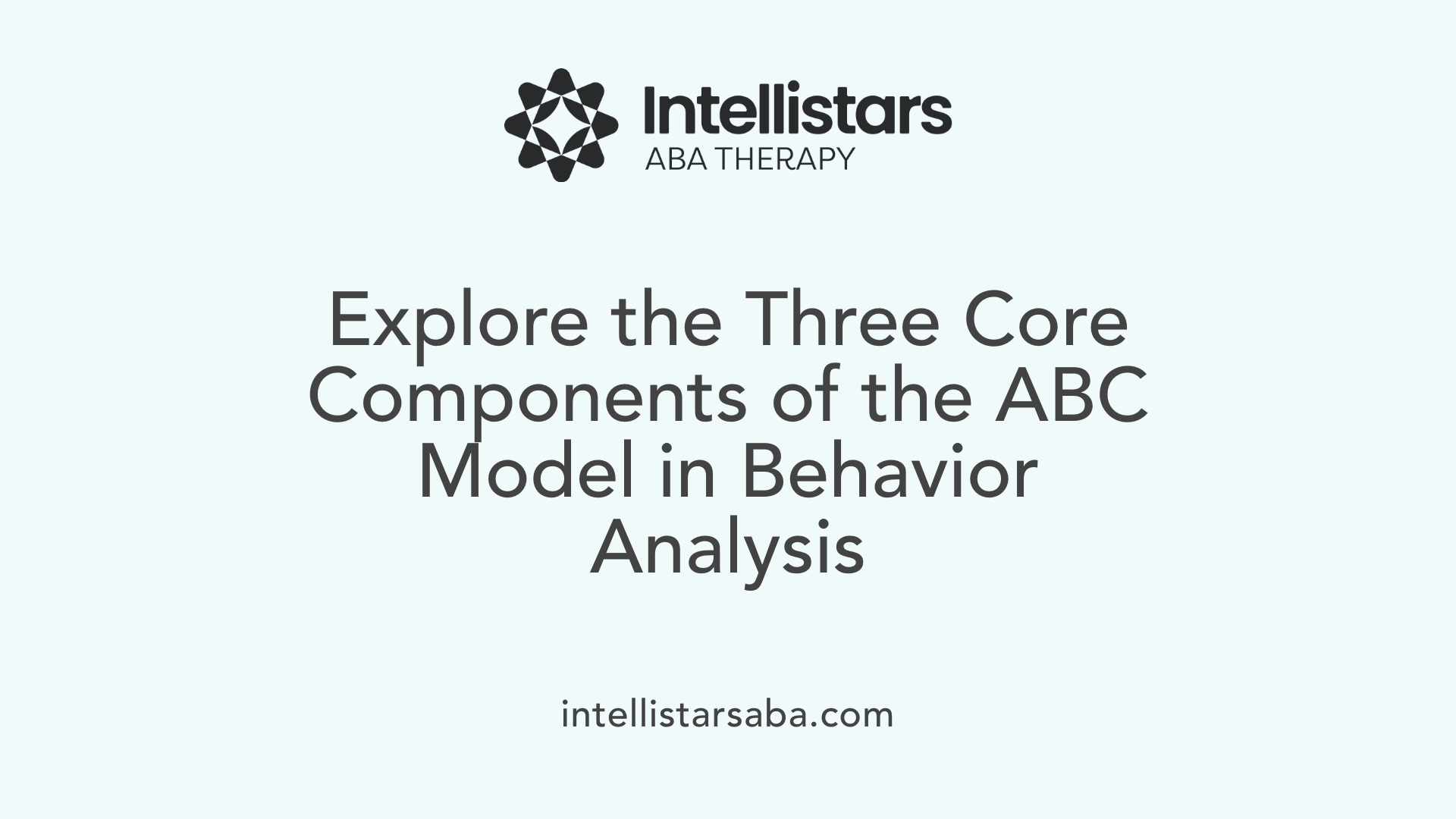
What are the three components of the ABC model used in behavior analysis?
The ABC model is a fundamental framework in Applied Behavior Analysis (ABA) for understanding and modifying behaviors. It consists of three parts: Antecedents, Behaviors, and Consequences.
Antecedents are the events or environmental factors that happen right before a behavior occurs. These can be triggers such as instructions, environmental conditions, or social cues. Recognizing antecedents helps identify what prompts the behavior.
Behaviors are the observable actions or responses made by an individual in reaction to antecedents. These behaviors can be positive, such as sharing or expressing needs politely, or problematic, like tantrums or aggression.
Consequences are what happen immediately after the behavior. They can reinforce the behavior by encouraging it to happen again, such as receiving praise or a reward, or they can discourage it, like a timeout or loss of privileges.
How do these components interact?
In the ABC framework, antecedents set the stage for a behavior, and the behavior itself is a response to these triggers. After the behavior occurs, the consequence can affect the likelihood of the behavior happening again.
For example, if a child is asked to put away toys (antecedent), the child might throw a tantrum (behavior). If the parent then gives the child a treat to calm down (consequence), this positive reinforcement increases the chances the child will react similarly in future situations.
By analyzing these interactions, therapists and parents can understand why behaviors happen and develop strategies to promote positive actions or reduce unwanted ones.
Using the model for assessment and intervention
The ABC model is invaluable in assessing behaviors. Through careful observation and data collection, professionals record what happens before, during, and after a behavior, creating a detailed picture of the behavior's function.
This information allows for tailored intervention plans. If problematic behaviors are linked to specific antecedents or reinforced by certain consequences, these factors can be modified. For example, changing cues or providing alternative, positive consequences can help in behavior management.
The ABC approach also encourages the use of positive reinforcement to strengthen desired behaviors and reduce the occurrence of undesirable ones. Its straightforward structure makes it accessible not only for professionals but also for parents and teachers to implement in daily routines.
Examples and Application of the ABC Framework
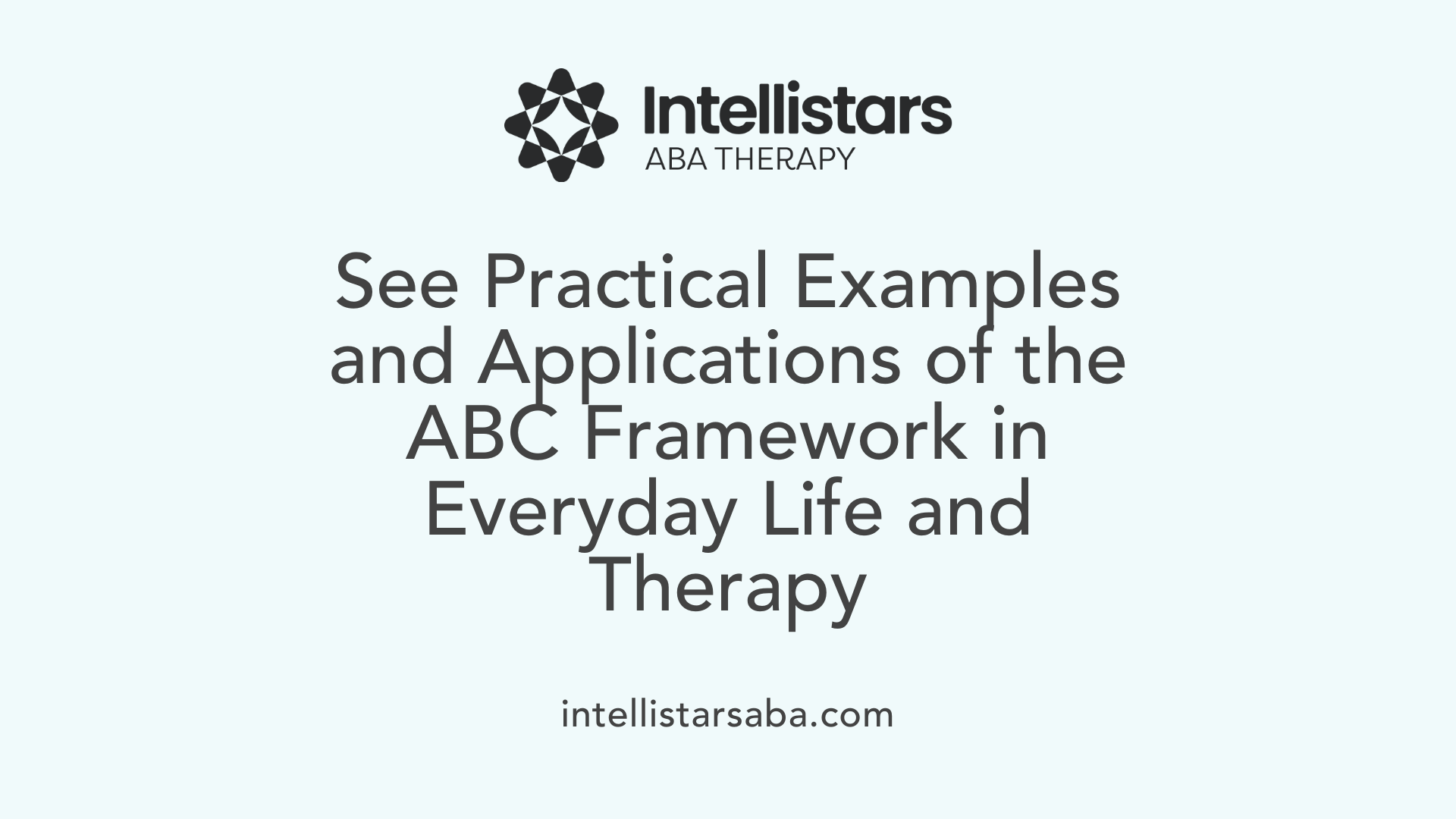 The ABC framework — standing for Antecedent, Behavior, and Consequence — is a fundamental tool in ABA that helps understand, analyze, and modify behaviors.
The ABC framework — standing for Antecedent, Behavior, and Consequence — is a fundamental tool in ABA that helps understand, analyze, and modify behaviors.
Practical examples of antecedents, behaviors, and consequences are abundant in daily life and therapeutic settings. For instance, an antecedent could be a caregiver asking a child to clean up their toys, which serves as a trigger. The child's behavior may be refusing or throwing toys, an observable action. The consequence might be the parent praising the child's effort when they pick up toys or the child being allowed to watch TV afterward.
Similarly, in a classroom, the teacher might give a prompt (antecedent), such as asking the student to answer a question. The student might respond correctly or refuse to engage (behavior). The follow-up could be immediate positive reinforcement like praise or a reward, or a negative outcome such as additional instructions.
Application in daily life and therapy involves observing these ABC parts to understand why certain behaviors happen and how to influence them. Parents and therapists track behaviors using ABC data, noting what triggers the behavior, what the behavior looks like, and what results follow. This detailed information supports creating effective Intervention Plans.
Using ABC data for intervention includes analyzing patterns to figure out roots of challenging behaviors. For example, if a child tantrums when denied a toy, the intervention might involve modifying antecedents (offering alternatives), reinforcing desirable behaviors (building patience), and adjusting consequences (praise for calmness). This structured approach makes behavior management more targeted and efficient.
Here is a quick overview of typical ABC components:
| Components | Examples | Details |
|---|---|---|
| Antecedent | Asking a child to do homework | Triggers the response |
| Behavior | Child refusing or crying | Observable reaction |
| Consequence | Getting attention or being ignored | Reinforces or discourages behavior |
Utilizing the ABC model in both natural environments and specialized therapy settings fosters better understanding and supports positive behavior change. Data collection through this model is straightforward and accessible, even for parents and teachers, making it a practical approach to behavioral analysis.
Applying the ABC Model in Behavior Management and Therapy
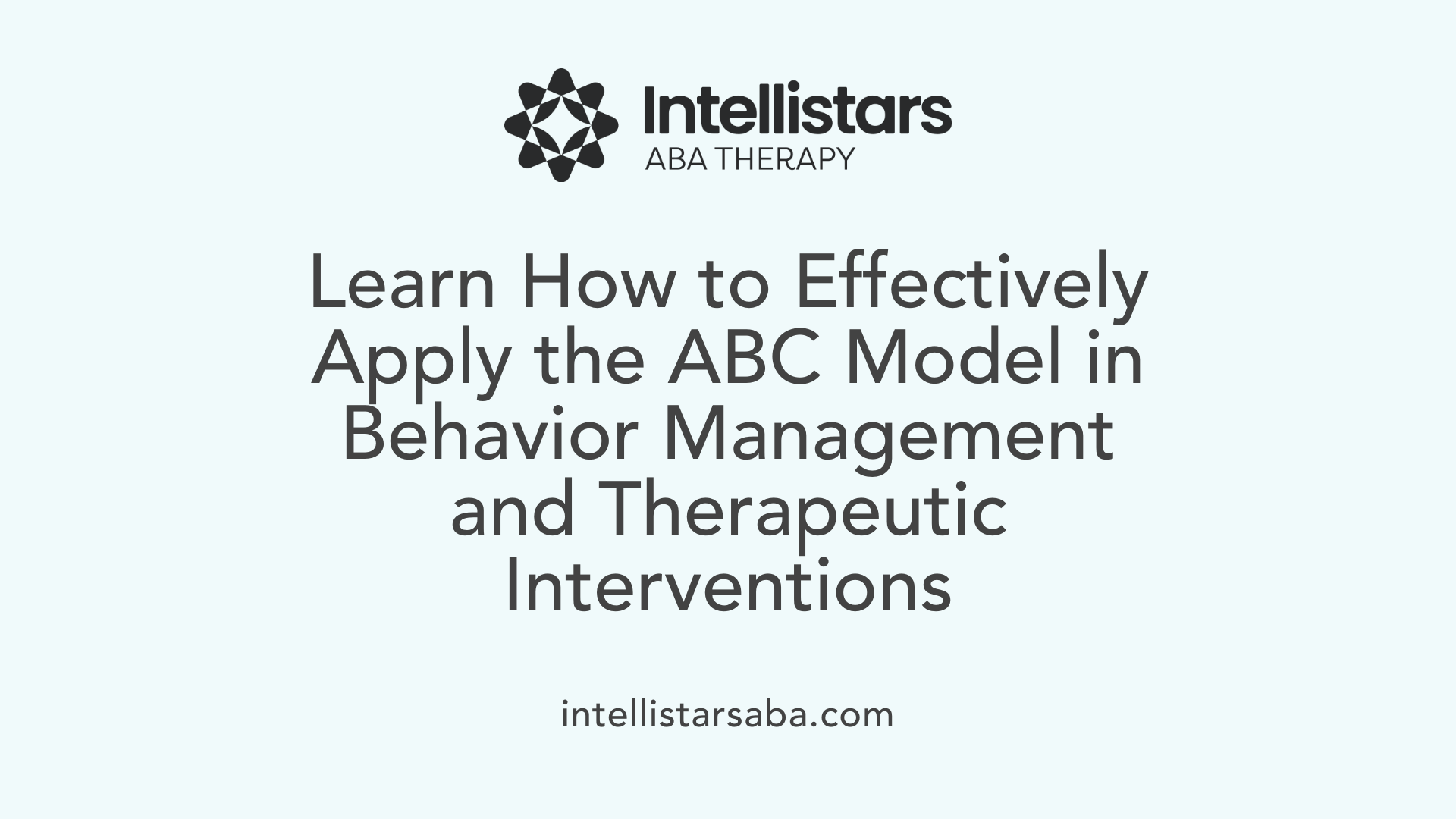
How does the ABC framework assist in behavior management and therapy?
The ABC model—standing for Antecedent, Behavior, and Consequence—is a fundamental tool in understanding and modifying behaviors. It provides a clear and systematic way to analyze why certain behaviors occur and how they can be changed.
In behavior management, practitioners and parents observe and record what happens before a behavior (the antecedent), the behavior itself, and what happens afterward (the consequence). This detailed tracking helps identify patterns and triggers that lead to undesirable behaviors or reinforce positive ones.
For example, if a child tantrums when asked to do homework (the antecedent), and the parent gives extra screen time afterward (the consequence), this reinforcement might encourage the tantrum in similar future situations.
By understanding these connections, interventions can be tailored to alter triggers or adjust consequences to shape behaviors more effectively.
In therapeutic settings, especially in cognitive-behavioral therapy, the ABC framework extends beyond observable actions. It helps clients recognize automatic or irrational thoughts (akin to beliefs) that contribute to feelings and behaviors. For instance, a person may believe “I will fail,” which triggers anxiety and avoidance. Identifying these beliefs and challenging them is a crucial part of therapy.
Practitioners use the ABC analysis to develop targeted strategies, whether modifying antecedents in everyday environments or reframing beliefs to foster healthier responses. The ongoing collection of ABC data enables continuous refinement of plans, increasing their effectiveness.
Systematic analysis of behavior
Analyzing behaviors systematically involves detailed recording of each event, often through logs, checklists, or video recordings. This method helps distinguish between different triggers and outcomes, revealing which factors most influence behaviors.
Professionals and caregivers can use this information to uncover underlying causes, whether environmental, emotional, or cognitive, and thus address the root of behavioral issues.
Intervention development
Interventions developed from ABC analysis are highly individualized. Strategies may include altering antecedents, like changing the environment or routine, or modifying consequences through positive reinforcement or natural feedback.
For example, in educational settings, teachers may alter prompts or expectations before a challenging task to promote engagement. Similarly, providing praise or rewards after positive behaviors strengthens their recurrence.
Behavioral interventions also often include teaching new skills or replacement behaviors that serve the same function but are more appropriate.
Real-world application
The ABC model is widely used both at home and in educational or clinical settings. Parents can observe and record behaviors to better understand triggers and implement effective consequences.
In schools, teachers apply the model to create behavior plans that promote a positive environment and improve students' social skills.
Professionals use the ABC framework within Behavior Intervention Plans and Functional Behavior Assessments to develop strategies that reduce challenging behaviors and foster skill development.
This approach’s versatility makes it valuable beyond therapy, applicable to habit formation, stress management, and daily routines.
| Aspect | Description | Example |
|---|---|---|
| Systematic analysis | Record and examine antecedents, behaviors, and consequences | Tracking daily classroom behaviors to identify triggers |
| Intervention development | Tailor strategies based on ABC data | Changing environment cues to prevent tantrums |
| Real-world application | Apply in homes, schools, and therapy | Using positive reinforcement to encourage study habits |
By using the ABC model systematically, both professionals and caregivers can create supportive environments that promote positive behaviors and reduce challenges, making it an essential part of behavior management and therapy.
Building a Foundation for Effective Behavior Support
Understanding the ABCs of behavior—Antecedents, Behavior, and Consequences—is pivotal in the field of ABA and beyond. This knowledge allows professionals, caregivers, and educators to develop targeted, data-driven interventions that address fundamental causes of behaviors. Through systematic observation and analysis, the ABC model supports the creation of personalized strategies that foster positive behaviors, diminish maladaptive responses, and promote overall well-being. Whether applied in clinical settings, homes, or schools, mastery of the ABC components enhances the effectiveness of behavior management and paves the way for meaningful skill development.
References
- The ABC's of ABA - Ally Behavior Centers
- What are the ABCs of Behavior?
- Mastering Behavior in ABA - The ABCs for Positive Change
- ABC Model in Applied Behavior Analysis - Collaborative Corner
- Understanding the ABCs of Behavior - Axis Therapy Centers
- Breaking Down the ABCs of Behavior in ABA Therapy
- The ABCs of Behavior For Children With Autism - Circle Care Services
- Applied Behavior Analysis (ABA) | Autism Speaks






